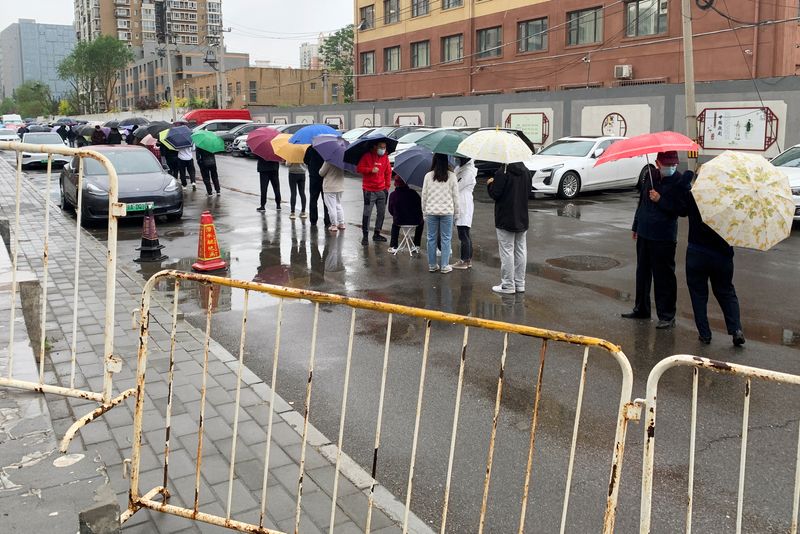(Reuters) – China is facing the biggest test yet of its draconian approach to COVID-19, with a lockdown for most people in Shanghai for more than a month crippling the commercial capital and Beijing scrambling to contain an outbreak and avert a similar crisis.
As most other countries in the world are learning to live with the virus, China’s “dynamic COVID-zero” policy is taking a heavy toll on economic growth, posing significant challenges for companies and causing fatigue and frustration among residents.
Here’s how it adds up.
INFECTIONS AND DEATHS:
In the current flare-up, mainland China reported over 600,000 locally transmitted COVID infections between March 1 and April 27. A total of 287 COVID deaths were detected during the period, with 285 in Shanghai.
There have been 4,923 coronavirus-related deaths reported in the country since the pandemic began.
While some observers have cast doubt over the accuracy of the official death tally, it is widely acknowledged there have been far fewer deaths than elsewhere in the world, thanks to strict enforcement of zero-COVID.
For comparison, the United States has recorded around 1 million deaths, while in India, the only country with a comparable population to China’s 1.4 billion people, there have been more than half a million deaths, officially.
LOCKDOWNS:
Analysts at Nomura estimate 46 cities are in full or partial lockdowns or other district-wide curbs, involving strict mobility restrictions on residents, affecting the lives of more than 343 million people. They contribute around 40.1 trillion yuan ($6.12 trillion), or 35% of the country’s economic output, according to Nomura.
Lockdowns in dozens of cities across the country, in particular Shanghai, risk upending global supply chains, according to analysts.
ECONOMIC FALLOUT:
The COVID outbreak is expected to take a heavy toll on China’s economic growth for the first half of this year, adding to geopolitical and property market headwinds. Hwabao Trust economist Nie Wen estimates a twin Beijing-Shanghai lockdown may trim one percentage point of China’s economic output in the second quarter.
Severe COVID restrictions, including lockdowns in major cities, have disrupted business and everyday life, prompting the government to step in with incentives to buoy economic growth, including infrastructure investment.
China’s first-quarter retail sales in at least 14 provinces, regions and municipalities lagged the national growth rate of 3.3%, according to official data. Movie box office revenue in China dropped 23% to 14 billion yuan ($2.14 billion) in the first quarter year-on-year, the Securities Times reported. Catering revenue fell 16.4% in March from a year earlier.
The country’s jobless rate stood at 5.8% in March, the highest since May 2020, official data showed. The jobless rate for people aged 16-24 hit a record high of 16% in March in eight months.
COMPANIES:
Industrial conglomerates GE and 3M, and chipmakers Texas Instruments and SK Hynix have warned that China’s COVID-19 curbs are further disrupting battered supply chains and hurting their revenue.
Many factories have been forced to shut at a time when businesses are already scrambling to keep up with soaring costs of everything from labour to raw materials.
Authorities have listed 666 companies allowed to resume operations in Shanghai, including U.S. carmaker Tesla. But industry bodies say those firms would be unable to produce much, as workers are stuck at home, trucks linger in parking lots, and orders of key components from contractors in a similar situation cannot be filled.
MARKETS:
The market focus is now shifting to Beijing, which is grappling to contain a nascent outbreak that has residents fearful authorities will impose a lockdown similar to Shanghai, prompting stockpiling of daily necessities.
The lockdown in Shanghai has rattled markets.
The benchmark Shanghai Composite Index has slumped nearly 9% so far in April, heading for its biggest monthly decline in six years. The blue-chip CSI300 Index dropped to two-year lows this week.
In the currency market, the yuan has tumbled nearly 4% so far in April, on track to post record monthly fall against the dollar.
Shanghai’s lockdown also disrupted the IPO market. A slew of Chinese companies seeking initial public offerings on Shanghai’s tech-focused STAR Market suspended their listing plans, citing impact from the epidemic.
(Reporting by Ellen Zhang, Roxanne Liu, Samuel Shen and Ryan Woo; Writing by Anne Marie Roantree; Editing by Tomasz Janowski)



















